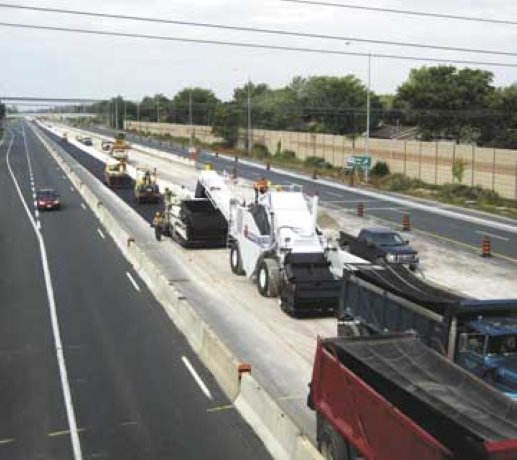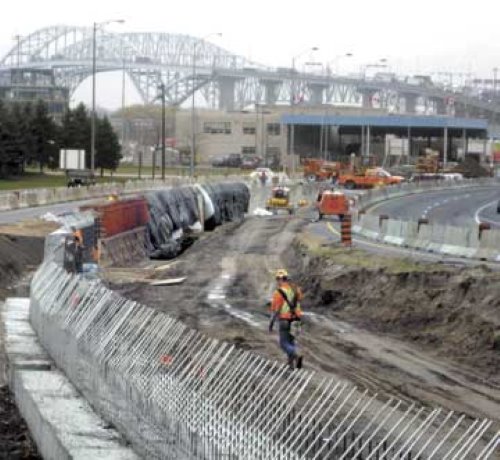The $60 million, four-kilometre widening of Highway 402 near the Blue Water Bridge to Michigan will uniquely reconfigure the road to four lanes going west and two lanes going east.
The widening is designed to reduce or eliminate traffic backups westbound along the highway, which is two lanes all the way from London to the three-lane Blue Water Bridge.
Another unique feature of the project is the rebuild of the Christina Street Bridge over Highway. 402.
This is believed to be the first example in southern Ontario of the use of expanded polystyrene blocks to accommodate extra traffic load from an increased bridge approach height, preventing the compression of soils beneath the highway.
The money for the project comes from federal-provincial border infrastructure funding, announced almost 10 years ago for various Ontario border improvements. The highway will also see the installation of six overhead variable message boards, including the largest of its kind in the province.
Stan Korosec, vice-president of operations for the Blue Water Bridge Authority, which manages the bridge’s Canadian half, and whose organization was consulted on the Highway 402 project, said the widening will do for traffic what the bridge already does.
The bridge already has the centre lane designated for NEXUS and FAST card holders approved by Canada and U.S. Customs for expedited border crossings as well as separate regular car and truck lanes.
“So it’s exactly the configuration that the designations we have on the bridge are out on the highway,” Korosec said.
Once the widening is completed by late summer, vehicles with permits are much less likely to be blocked from entering the bridge’s designated lanes because those lanes will be extended four kilometres to Murphy Road.
“So we get those out of the queues and it helps reduce the idling,” Korosec said. “It gives them the advantage of not stopping.”
Ministry of Transportation area engineer Brian Kope said the project required the demolition of the old Christina Street bridge, the city’s main downtown thoroughfare, and the building of a lengthier bridge over the wider Highway. 402. Three other bridges and two underpasses were long enough to accommodate the project although they did receive rehabilitation. Kope said a new ramp to Christina Street allows motorists to turn left to go towards downtown rather than the previous right or north bound turn only.
Kope said he is “not aware” of any other irregular freeway road configuration with more lanes on one side than the other, as in this project. But Korosec said it makes sense given that traffic headed into Canada from the U.S. doesn’t get backed up on the Canadian side. ”Going eastbound once you clear Canada Customs two lanes are fine because traffic just moves,” he said.
The bridge authority has been priding itself on ease of access, especially when compared to the busier but often choked Ambassador Bridge a further 90 kilometres south between Windsor and Detroit. He suggests this has drawn business because truckers “know they’re not going to be delayed.”
Widening is taking place on the U.S. side with Interstates 94 and 69.
Meanwhile Kope said that the widening didn’t necessitate expropriation but space was available on provincial land. However, a grass median had to be replaced by an additional lane and a tall-wall barrier put in its place. Former lanes were excavated with the sub-grade built up topped by concrete to accommodate heavier trucks. Oakville’s Bot Construction Group has about 40 workers (seasonally-adjusted) on the site. Winemann Electric Ltd. of Fort Erie will install the message boards this fall.
Sound barriers have also been moved out wider and increased from 4.5 to five metres in height because of the “fair amount” of nearby local homes, Kope said.
On the Christina Street bridge, form liners were used to create textured stone appearances on abutments, pier and parapet walls.
A new four-metre deep storm sewer was installed on the north side of the highway along with three storm management ponds ”to basically deal with the median barrier wall and the catch basins that are along the centre of the highway” as well as the additional lanes, Kope said.
Christina Street bridge demolition had to be done within two 12-hour intervals, the maximum detour time allowed for Highway. 402 traffic. Meanwhile the Ontario Provincial Police only stopped traffic for 15 -minute intervals while 20 girders were swung into place for the new bridge.
The higher elevation of the bridge required the “special feature” of extended polystyrene blocks measuring as large as 2.4 by 1.2 by 0.5 metres and fitting together to a depth of a maximum of 11 rows, and tapering off like a ”jigsaw puzzle,” he said.
“Once the load is on to the Styrofoam, it moves through the styrofoam like it moves through the soil,” he said. That’s topped by asphalt and concrete. The blocks absorb and distribute the load.
“And that’s the important thing,” Kope said. “If you keep the load the same, then obviously the soils will have no reason to compress more.”




Recent Comments
comments for this post are closed